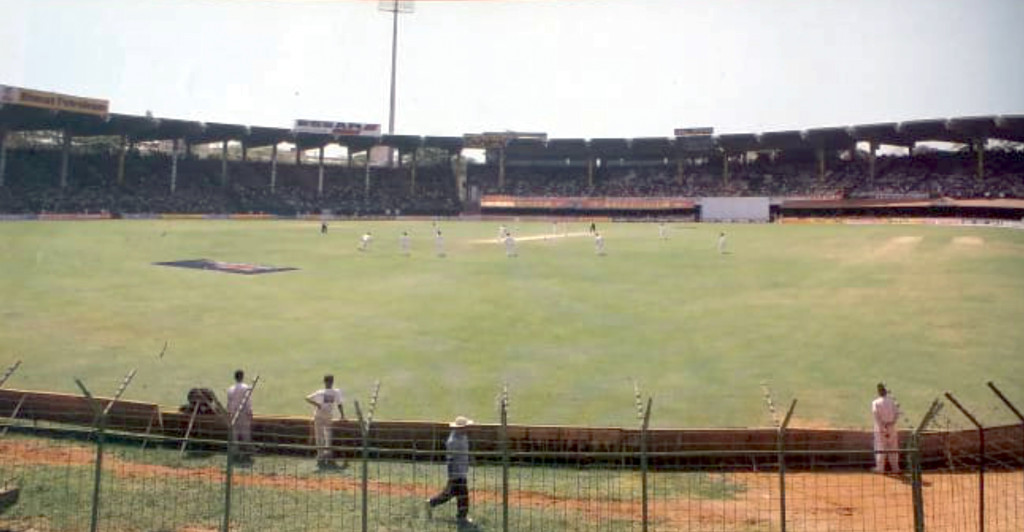Registered with the Registrar of Newspapers for India under R.N.I 53640/91
Vol. XXIX No. 4, June 1-15, 2019
Random thoughts on reporting Cricket at Chepauk
by Partab Ramchand

The Chepauk Stadium with jam-packed crowd during one the matches.
As a professional sports writer for over half a century, specializing in cricket I obviously have very fond memories of Chepauk or the M.A. Chidambaram stadium. In my active days as a journalist the stadium and the TNCA office used to be almost my daily beat either to cover matches, make inquiries to follow up on stories or interview cricketers. It used to be my second home. Everyone knew me and I knew everyone. And from the old press box which is directly opposite to the much more comfortable new press enclosure now at the stadium it was my good fortune to cover several Tests and ODIs for the publications I represented starting with the Test against Australia in 1969.
Actually my first visit to Chepauk was in January 1967 for the Test against Gary Sobers’ West Indian side. That match marked the return of Test cricket to the hallowed ground after Tests had been played at the Corporation stadium in Park Town for about ten years. Even now I announce proudly that I saw Sobers in action and he did not disappoint scoring 95 and 74 not out besides taking his usual quota of wickets and catches.
There was no stadium in those days. Temporary wooden structures were built to accommodate the spectators but the cricket fans took the uncomfortably cramped seating arrangements in their stride. The foundation stone for the stadium was laid in February 1971 and the structure came up in stages due to the enormous expenses involved. It was only in 1980 that the stadium was completed and given its present name after one of the most prominent cricket administrators in the country.
Through the 70s, 80s and 90s and into the first few years of the new millennium I never missed a big match at Chepauk thanks to my official capacity but being a cricket lover I would probably have gone for the matches even if I was not a sports reporter. However since I retired some 15 years ago I have not been to the stadium except once when a young journalist took me there to see the new press enclosure. These days I prefer to see the matches on TV in the comfort of my home.
Obviously the ambience is very different from the days when I used to report on the matches what with the colourful banners, the big screen that shows the action and the replays and the cheer leaders (thankfully only for the IPL matches). These days it is all hype and razzmatazz and technical wizardry. What a metamorphosis from the staid cricket match of thirty or forty years ago!
As a facts and figures man it has been my good fortune to witness many world records at Chepauk most notably Sunil Gavaskar’s 30th Test hundred in 1983 which put him ahead of Don Bradman’s tally and Narendra Hirwani’s 16 for 136 in 1988 – still the best figures ever by a bowler in his first Test match. There are of course several other records but I have also been fortunate to witness an innings that was not a record but is part of cricketing folklore – Gundappa Viswanath’s immortal 97 not out against West Indies in 1975.
Among matches I reported on, pride of place must surely go to the Tied Test II in September 1986. There was also the first ODI played at Chepauk – the World Cup match between India and Australia in 1987 and the first day/night ODI – the World Cup quarterfinal between Australia and New Zealand in 1996.
The conduct of the big games at Chepauk has always received the highest praise from the cricketers while the spectators have carved out a niche all their own. “The most sporting crowd in India is the Chepauk crowd’’ is a cliché symbolized by the standing ovation given to the victorious Pakistan team in January 1999. They had just witnessed India go down by 12 runs but shrugged off the disappointment to make a gesture that had Javed Miandad exclaim “Salaam Chennai”.
For most of the big matches Chepauk has always had a capacity or near capacity crowd. When the stadium was completed it could hold 50,000 spectators. Now with the structure changed to allow the sea breeze to come in and with the seating too changed to make for more comfortable viewing the capacity has come down to a little over 40,000.
Unfortunately with the three stands on the west side of the stadium remaining empty over a dispute it reduces the capacity to about 28,000. Frankly for someone like me who has seen matches along with 50,000 spectators I feel very sad every time the cameras show the empty stands which are like an eyesore. The sooner a solution is found to the problem the better for all concerned.


Thanks, for this write-up.